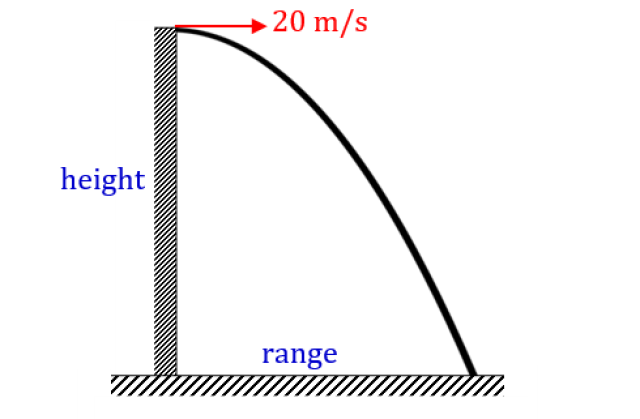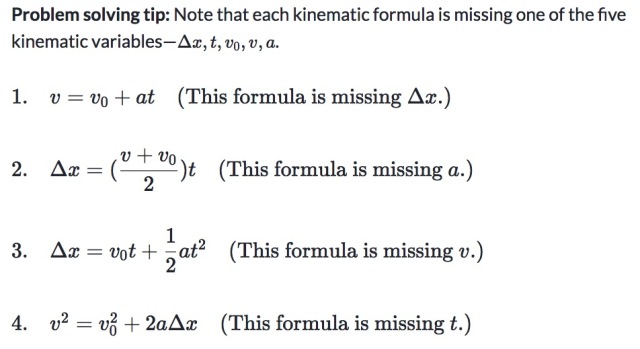A person kicks a rock off a cliff horizontally with a speed of 20 m/s. It takes 7.0 seconds to hit the ground. Find:
a) The height of the cliff.
b) The final velocity of the rock just before it hits the ground.
c) The distance the rock travels horizontally before it hits the ground.
it needs to be drawn but I have no clue how.
PHYSICS HELP please :(?
2020-09-23 2:23 am
回答 (3)
2020-09-23 2:55 am
✔ 最佳答案
Refer to the figure below.Take g = 9.8 m/s²
Take all downward quantities to be positive.
(a)
Consider the vertical motion (uniform acceleration motion):
Initial velocity, u(y) = 0 m/s
Acceleration, a(y) = 9.8 m/s²
Time taken, t = 7.0 s
s(y) = u(y) t + (1/2) a t²
s(y) = (0) (7) + (1/2) (9.8) (7)²
Height of the cliff, s(y) = 240 m
(b)
Consider the vertical motion:
v(y) = u(y) + a(y) t
v(y) = (0) + (9.8) (7)
v(y) = 68.6 m/s
Final velocity of the rock
= √[v(x)² + v(y)²]
= √[20² + 68.6²]
= 71.5 m/s
Make an angle of tan⁻¹(68.6/20) = 73.7° below the horizontal line.
(c)
Consider the horizontal motion (uniform velocity motion):
Distance the rock travels horizontal before it hits the ground (range)
= v(x) t
= (20) (7)
= 140 m

2020-09-23 4:09 am
a) The height of the cliff.
g = gravitational acceleration = 9.81 m/s²
viy = initial velocity in the vertical direction = 0 m/s
t = elapsed time of fall = 7.0 s
Δy = height of cliff (vertical distance) = to be determined
Δy = viy∙t + 0.5gt²
Δy = 0 m/s∙7.0 s + 0.5(9.81 m/s²)(7.0 s)²
Δy = 240.345 m = 240 m
b) The final velocity of the rock just before it hits the ground.
vfx = velocity in the horizontal direction = 20 m/s
vfy = final velocity in the vertical direction = to be determined
Vr = resultant final velocity = to be determined
vfy = viy + gt
vfy = 0 m/s + (9.81 m/s²)(7.0 s)
vfy = 68.67 m/s = 69 m/s
Vr = √[(vfx)² + (vfy)²]
Vr = √[(20 m/s)² + (69 m/s)²]
Vr = 71.52320533 m/s = 72 m/s
c) The distance the rock travels horizontally before it hits the ground.
vfx = velocity in the horizontal direction = 20 m/s
t = elapsed time of fall = 7.0 s
Δx = horizontal distance = to be determined
vfx = Δx / t
vfx∙t = Δx
Δx = vfx∙t
Δx = 20 m/s∙7.0 s
Δx = 140 m
g = gravitational acceleration = 9.81 m/s²
viy = initial velocity in the vertical direction = 0 m/s
t = elapsed time of fall = 7.0 s
Δy = height of cliff (vertical distance) = to be determined
Δy = viy∙t + 0.5gt²
Δy = 0 m/s∙7.0 s + 0.5(9.81 m/s²)(7.0 s)²
Δy = 240.345 m = 240 m
b) The final velocity of the rock just before it hits the ground.
vfx = velocity in the horizontal direction = 20 m/s
vfy = final velocity in the vertical direction = to be determined
Vr = resultant final velocity = to be determined
vfy = viy + gt
vfy = 0 m/s + (9.81 m/s²)(7.0 s)
vfy = 68.67 m/s = 69 m/s
Vr = √[(vfx)² + (vfy)²]
Vr = √[(20 m/s)² + (69 m/s)²]
Vr = 71.52320533 m/s = 72 m/s
c) The distance the rock travels horizontally before it hits the ground.
vfx = velocity in the horizontal direction = 20 m/s
t = elapsed time of fall = 7.0 s
Δx = horizontal distance = to be determined
vfx = Δx / t
vfx∙t = Δx
Δx = vfx∙t
Δx = 20 m/s∙7.0 s
Δx = 140 m
2020-09-23 2:25 am
y(t) = ½at² + v₀t + y₀ is the basic formula you need to know.
Standard gravity is -9.80665 m/s²
For speed KE=PE, ie 1/2mv² = mgh
Here are the resolved Kinetics formulas:
Standard gravity is -9.80665 m/s²
For speed KE=PE, ie 1/2mv² = mgh
Here are the resolved Kinetics formulas:

收錄日期: 2021-04-24 08:08:58
原文連結 [永久失效]:
https://hk.answers.yahoo.com/question/index?qid=20200922182308AAA1eCW

